CBSE Sample Papers for Class 12 Chemistry Set-1
Class 12thCBSE Sample Papers for Class 12 Chemistry Set-1
CBSE Sample Papers for Class 12 Chemistry Set 1 with Solutions
Time: 3 hrs
Max. Marks: 70
General Instructions
Read the following instructions carefully.
- There are 33 questions in this question paper with internal choice.
- Section A consists of 16 multiple-choice questions carrying 1 mark each.
- Section B consists of 5 short answer questions carrying 2 marks each.
- Section C consists of 7 short answer questions carrying 3 marks each.
- Section D consists of 2 case-based questions carrying 4 marks each
- Section E consists of 3 long answer questions carrying 5 marks each.
- All questions are compulsory.
Section
A
(The following questions are
multiple-choice questions with one correct answer. Each question carries 1 mark.
There is no internal choice in this section.)
Question 1.
Which of the following solutions will have the highest
conductivity at 298 K? [1]
(a) 0.01 M HCl solution
(b) 0.1 M HCl
solution
(c) 0.01 M CH3 COOH solution
(d) 0.1 M CH3
COOH solution
Answer:
(b) 0.1 M HCl solution
0.1 M HCl solution have highest conductivity at 298 K. Conductivity is highest for strong electrolyte. It decreases with dilution.
Question 2.
Identify A and B. [1]
(a) A = 1-phenylethanal, B =
Acetophenone
(b) A = Benzophenone, B = Formaldehyde
(c) A = Benzaldehyde,
B = Acetophenone
(d) A = Benzophenone, B = Acetophenone
Answer:
(c) A =
Benzaldehyde, B = Acetophenone
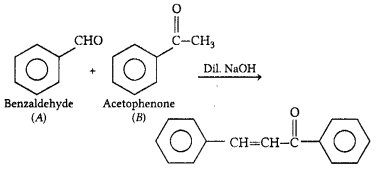
This reaction is an example of crossed aldol condensation
reaction.
Question 3.
The vitamins which can be stored in our body are [1]
(a)
vitamin A, B, D and E
(b) vitamin A, C, D and K
(c) vitamin A, B, C and
D
(d) vitamin A, D, E and K
Answer:
(d) vitamin A, D, E and K
Fat soluble vitamins can be stored in our body, e.g. Vitamin A, D, E and K.
Question 4.
What is IUPAC name of the ketone A, which undergoes iodoform
reaction to give CH3CH = C(CH3 )COONa and yellow
precipitate of CHl3 ? [1]
(a) 3-methylpent-3-en-2-one
(b)
3-methylbut-2-en- one
(c) 2, 3-dimethylethanone
(d) 3-methylpent-4-one
Answer:
(a) 3-methylpent-3-en-2-one
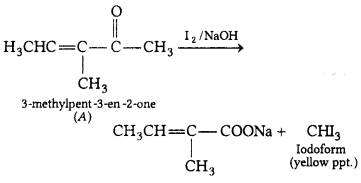
Question 5.
Which of the following is not correct?
(a) In haloarenes,
the electron pairs on halogen atom are in conjugation with π-electrons of the
ring.
(b) The carbon-magnesium bond is covalent and non-polar in nature.
(c) During SN1 reaction, the carbocation formed in the slow step
being sp2-hybridised is planar.
(d) Out of CH2 = CH—Cl
and C6H5CH2Cl,
C6H5CH2Cl is more reactive towards
SN1 reaction. [1]
Answer:
(b) The carbon-magnesium bond is
covalent and non-polar in nature.
Statement (b) is incorrect as carbon magnesium bond is polar in nature.
Question 6.
Match the properties with the elements of 3d- series [1]
| (i) lowest enthalpy of atomisation | (p) sc |
| (ii) shows maximum number of oxidation states | (q) Mn |
| (iii) transition metal that does not form coloured compounds | (r) Zn |
| (s) Ti |
(a) (i) (r), (ii) (q), (iii) (p)
(b) (i) (r), (ii) (s), (iii) (p)
(c)
(i) (p), (ii) (q), (iii) (r)
(d) (i) (s), (ii) (r), (iii) (p)
Answer:
(a) (i) (r), (ii) (q), (iii) (p)
The correct match is (i)-(r), (ii)-q, (iii)-p.
(i) The lowest enthalpy of
atomisation is of Zn. As it has no unpaired electrons in 3s or 4s-orbital.
(ii) In 3d-series the maximum oxidation state is shown by Mn as it has 5
unpaired of electron in 3d-orbital.
(iii) In the ground state of Sc, it has
one electron in the 3d-subshell, but in its common oxidation state it has no
electron in 3d-subshell. Hence, it does not form coloured compound.
Question 7.
Which of the following statement is true?
(a) Molecularity
of reaction can be zero or a fraction.
(b) Molecularity has no meaning for
complex reactions.
(c) Molecularity of a reaction is an experimental
quantity.
(d) Reactions with the molecularity three are very rare but are
fast. [1]
Answer:
(b) Molecularity has no meaning for complex
reactions.
Molecularity is a theoretical concept. It is applicable to elementary reaction. For complex reaction, it has no meaning.
Question 8.
In which of the following solvents, the
C4H8NH3+X– is soluble.
[1]
(a) ether
(b) acetone
(c) water
(d) bromine water
Answer:
(c) water
Question 9.
Which of the following observation is shown by 2 -phenyl
ethanol with Lucas reagent? [1]
(a) Turbidity will be observed within five
minutes.
(b) No turbidity will be observed.
(c) Turbidity will be observed
immediately.
(d) Turbidity will be observed at room temperature but will
disappear after five minutes.
Answer:
(b) No turbidity will be
observed.

The 2-phenyl ethanol is a primary alcohol, and primary
alcohols do not produce turbidity at room temperature.
Question 10.
If the initial concentration of substance A is 1.5 M and
after 120 seconds the concentration of substance A is 0.75 M, the rate constant
for the reaction if it follows zero order kinetics is [1]
(a) 0.00625
molL-1s-1
(b) 0.00625 s-1
(c) 0.00578 mol
L-1s-1
(d) 0.00578 s-1
Answer:
(a)
0.00625 molL-1s-1
Initial concentration of A = 1.5 M
Final concentration of A = 0.75 M, Time
= 120 s
For zero order reaction, k = \(\frac{\left[R_0\right]-[R]}{t}\) =
\(\frac{1.50-0.75}{120}\)
= \(\frac{0.75}{120}\) = 0.00625 mol
L-1s-1
Question 11.
Anisole undergoes bromination with bromine in ethanoic acid
even in the absence of iron (III) bromide catalyst [1]
(a) due to the
activation of benzene ring by the methoxy group
(b) due to the de-activation
of benzene ring by the methoxy group
(c) due to the increase in electron
density at ortho and para-positions
(d) due to the formation of stable
carbocation
Answer:
(a) due to the activation of benzene ring by the
methoxy group
The given reaction occurs because of the activation of benzene ring by the methoxy group.
Question 12.
The trend of which property is represented by the following
graph? [1]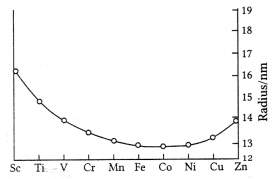
(a) Ionisation enthalpy
(b) Atomic radii
(c) Enthalpy
of atomisation
(d) Melting point
Answer:
(b) Atomic radii
The given graph is for atomic radii. Atomic radii decrease with increase in
atomic number.
However, at the end of the series, size of elements increases
due to the increases in the magnitude of repulsive forces between electrons.
Question 13.
Given below are two statements labelled as Assertion (A) and
Reason (R). [1]
Assertion (A) Alcohols react both as nucleophiles and
electrophiles.
Reason (R) The bond between C—O is broken when alcohols react
as nucleophiles.
Select the most appropriate answer from the options given
below.
(a) Both A and R are true and R is the correct explanation of A.
(b) Both A and R are true but R is not the correct explanation of A.
(c) A is
true but R is false.
(d) A is false but R is true.
Answer:
(c) A is
true but R is false.
(A) is true but (R) is false. The correct (R) is : The
bond between C—O is broken when alcohol reacts as electrophiles.
Question 14.
Given below are two statements labelled as Assertion (A) and
Reason (R).
Assertion (A) Strong oxidising agents oxidise toluene and its
derivatives to benzoic acids.
Reason (R) It is possible to stop the oxidation
of toluene at the aldehyde stage with suitable reagents.
Select the most
appropriate answer from the options given below. [1]
(a) Both A and R are
true and R is the correct explanation of A.
(b) Both A and R are true but R
is not the correct explanation of A.
(c) A is true but R is false.
(d) A
is false but R is true.
Answer:
(b) Both A and R are true but R is not the
correct explanation of A.
Question 15.
Given below are two statements labelled as Assertion (A) and
Reason (R).
Assertion (A) Enzymes are very specific for a particular reaction
and for a particular substrate.
Reason (R) Enzymes are biocatalysts. Select
the most appropriate answer from the options given below. [1]
(a) Both A and
R are true and R is the correct explanation of A.
(b) Both A and R are true
but R is not the correct explanation of A.
(c) A is true but R is false.
(d) A is false but R is true.
Answer:
(b) Both A and R are true but R is
not the correct explanation of A.
Both (A) and (R) are true but (R) is not the correct explanation of (A). Each enzyme contains an active site which has specific shape and size.
Question 16.
Given below are two statements labelled as Assertion (A) and
Reason (R).
Assertion (A) During electrolysis of aqueous copper sulphate
solution using copper electrodes hydrogen gas is released at the cathode.
Reason (R) The electrode potential of Cu2+/ Cu is greater than that
of H+ /H2. [1]
Select the most appropriate answer from
the options given below.
(a) Both A and R are true and R is the correct
explanation of A.
(b) Both A and R are true but R is not the correct
explanation of A.
(c) A is true but R is false.
(d) A is false but R is
true.
Answer:
(d) A is false but R is true.
(A) is false but (R) is true. As during electrolysis of aqueous copper sulphate solution using copper electrode, copper is deposited at cathode.
Section
B
(This section contains 5
questions with internal choice in one question. The following questions are
very short answer type and carry 2
marks each.)
Question 17.
(a) Radioactive decay follows first order kinetics. The
initial amount of two radioactive elements X and F is 1 g each. What will be the
ratio of X and Y after two days if their half-lives are 12 h and 16 h
respectively? [2]
Answer:
Given : Half-life of X = 12 hr
Half-life of Y
= 16 hr
Time = 2 days = 48 hours
For first order reaction,
Half-life of
X after 2 days = \(\frac{48}{12}\) = 4
Amount of X left after 4 half lives =
\(\frac{1}{16}\) of initial
value half-life of Y after 2 days =
\(\frac{48}{16}\) =3.
Amount of Y left after 3 half lives = \(\frac{1}{8}\)
of initial value.
Ratio of X : Y = 1 : 2
(b) The hypothetical reaction P + Q → R is half order w.r.t ‘P’ and zero
order w.r.t ‘Q. What is the unit of rate constant for this reaction?
Answer:
For the reaction, P + Q → R
Rate = k[P]1/2[Q]°
=k[P]1/2
General formula for determination of unit is
mol1-nLn-1s-1.
So, for \(\frac{1}{2}\) order
reaction, unit is mol1/2L-1/2s-1.
Question 18.
A 5% solution of Na2SO4 ∙
10H2O (molecular weight = 322) is isotonic with 2% solution of
non-electrolytic, non-volatile substance X. Find out the molecular weight of X.
[2]
Answer:
Molecular mass of Na2SO4 ∙ 10H2O =
322
For isotonic solution osmotic pressure is same.
∴
π1(Na2SO4 ∙ 10 H2O) = π2
(non-electrolyte)
⇒ iC1RT = C2RT
For
Na2SO4 – 10H2O,
i = 3
⇒ \(\frac{3 \times
5}{322}\) = \(\frac{2}{M}\)
⇒ M = \(\frac{2 \times 322}{3 \times 5}\)
[where, M = molecular weight of non-electrolyte] = 42.9 g
Thus, the molecular
weight of non electrolyte is 42.9g.
Question 19.
(a) Arrange the isomeric dichlorobenzene in the increasing
order of their boiling point and melting points. [2]
Answer:
m-dichlorobenzene < o -dichlorobenzene < p-dichlorobenzene.
The
p-isomer have high melting point as compared to o- and m-isomer. This is due to
the symmetry of p-isomer compared to m-and o-isomers.
(b) Explain why the electrophilic substitution reactions in haloarenes occur
slowly and require more drastic conditions as compared to those in benzene?
Answer:
The resonance structure of haloarenes are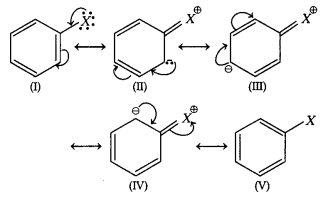
The electron density in haloarenes increases more at o- and
p-positons than at m-positions. Hence, electrophilic reactions occur at o- and
p-position. The halogen atom has the tendency to withdraw electrons due to which
electron density on benzene ring decreases (—I-effect) and the ring gets
deactivate.
Hence, eletrophilic substitution in haloarenes occurs at a slow
rate.
Question 20.
(a) Out of p-tolualdehyde and p-nitrobenzaldehyde, which one
is more reactive towards nucleophilic addition reactions, why? [2]
Answer:
p-nitrobenzaldehyde is more reactive towards the nucleophilic
addition reaction than p-tolualdehyde as —NO2 group is electron
withdrawing in nature. Presence of nitro group decreases electron density.
Hence, facilitates the attack of nucleophile. Presence of —CH3 leads
to +I-effect as CH3 is electron donating group.
(b) Write the structure of the product formed when acetone reacts with
2,4-DNP reagent.
Answer:
Or
Convert the following. [2]
(a) Benzene to m-nitrobenzaldehyde
(b)
Bromobenzene to benzoic acid
Answer:
(a) Benzene to
m-nitrobenzaldehyde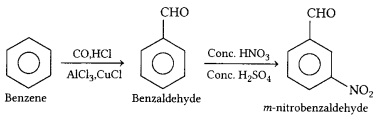
(b) Bromobenzene to benzoic acid
Question 21.
(a) DNA fingerprinting is used to determine paternity of an
individual. Which property of DNA helps in the procedure?
(b) What structural
change will occur when a native protein is subjected to change in pH? [2]
Answer:
(a) A sequence of bases on DNA is unique for a person and is the
genetic material which is transferred to the individual from the parent. This
helps in the determination of paternity.
(b) When a native protein is
subjected to change in pH, the denaturation of secondary and tertiary structure
of protein takes place. Whereas the primary structure remains intact.
Section
C
(This section contains 7
questions with internal choice in one question. The following questions are
short answer type and carry 3 marks each.)
Question 22.
(a) Write the formula for the following coordination
compound.
Bis(ethane-1,2-diamine)dihydroxidochro mium (III) chloride
(b)
Does ionisation isomer for the following compound exist? Justify your answer.
Hg[Co(SCN)4]
(c) Is the central metal atom in coordination
complexes a Lewis acid or a Lewis base? Explain. [3]
Answer:
(a)
[Cr(en)2(OH)2] Cl
or
[Cr(H2NCH2CH2NH2)2(OH)2]Cl
(b) In the given compound ionisation isomers are not possible. This is because
ionisation isomers are possible by exchange of ligand with counter ion only and
not by exchange of central metal ion.
(c) The central metal in coordination
complexes is act as a electron pair acceptor. Thus, it behaves as Lewis
acid.
Question 23.
(a) Can we construct an electrochemical cell with two
half-cells composed of ZnSO4 solution and zinc electrodes? Explain
your answer.
(b) Calculate the λ°m for Cl– ion from the
data given below.
(c) The cell constant of a conductivity cell is 0.146
cm-1. What is the conductivity of 0.01 M solution of an electrolyte
at 298 K, if the resistance of the cell is 1000 ohm? [3]
Answer:
(a) Yes,
we can construct an electrochemical cell the concentration of ZnSO4
in the two half-cell is different, the electrode potential will be different
making the cell possible.
(b) Given,
\(\Lambda_{\mathrm{m}\left(\mathrm{MgCl}_2\right)}^{\circ}\) = 258.6 S
cm2 mol-1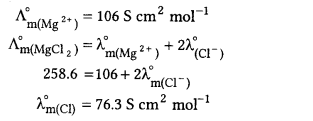
(c) Given, cell constant, G* = 0.146 cm-1
Resistivity, R = 1000 ohm
Also, G* = k × R
k = \(\frac{G^*}{R}\) =
\(\frac{0.146}{1000}\) = 146 × 10-4 S cm-1
Question 24.
Write the name of the reaction, structure and IUPAC name of
the product formed when
(a) phenol reacts with CHCl3 in the
presence of NaOH followed by hydrolysis.
(b)
CH3CH2CH(CH3)CH (CH3)ONa reacts with
C2H5Br. [3]
Answer:
(a) Phenol reacts with
CHCl3 in the presence of NaOH followed by hydrolysis form 2-hydroxy
benzaldehyde. This reaction is known as Reimer-Tiemann.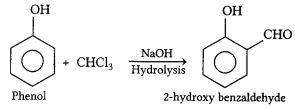
(b) Alkoxide reacts with alkyl halide to form ether. This
reaction is called Williamson’s synthesis.
Question 25.
You are given four organic compounds A, B, C and D. The
compounds A, B and C form an orange- red precipitate with 2, 4-DNP reagent.
Compounds A and B reduce Tollen’s reagent while compounds C and D do not. Both B
and C give a yellow precipitate when heated with iodine in the presence of NaOH.
Compound D gives brisk effervescence with sodium bicarbonate solution. Identify
A, B, C and D given the number of carbon atoms in three of these carbon
compounds is three while one has two carbon atoms. Give an explanation for your
answer. [3]
Answer:
According to the question, A, B and C, contain
carbonyl group as they form an orange-red precipitate with 2,4-DNP reagent.
A
and B reduces Tollen’s reagent, thus they are aldehydes.
C is a ketone as it
contains carbonyl group but does not give positive Tollen’s test. As C gives
positive iodoform test, thus it is a methyl ketone.
B gives positive iodoform
test, thus it is an aldehyde.
D is a carboxylic acid, as it gives brisk
effervescence with bicarbonate solution.
Since, the number of carbons in the
compounds A,B,C and D is either three or two, therefore B is CH3CHO
as this is the only aldehyde which gives a positive iodoform test.
The
remaining compounds A, C, and D have three carbons.
A =
CH3CH2CHO; C=CH3COCH3 ; D=
CH3CH2COOH(3)
Question 26.
When sucrose is hydrolysed the optical rotation values are
measured using a polarimeter and are given in the following table. [3]
(a) Account for the two specific rotation values.
(b) What
is the specific name given to sucrose based on the above observation?
(c) One
of the products formed during the hydrolysis of sucrose is a glucose, that
reacts with hydroxylamine to give compound A. Identify compound A.
Answer:
(a) Sucrose is dextorotatory but after hydrolysis, gives
dextrotarotory glucose and leavorotatory fructose.
Since, the laevorotation
of fructose (-92.4°) is more than dextrorotation of glucose (+52.5°), the
mixture is laevorotatory.
(b) The hydrolysis of sucrose brings about a change
in the sign of rotation from dextro (+) to laevo (-) and the product is named as
invert sugar.
(c)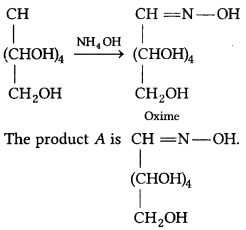
Question 27.
An organic compound A with the molecular formula (+)
C4H9Br undergoes hydrolysis to form (+)
C4H9OH. Give the structure of A and write the mechanism of
the reaction. [3]
Answer: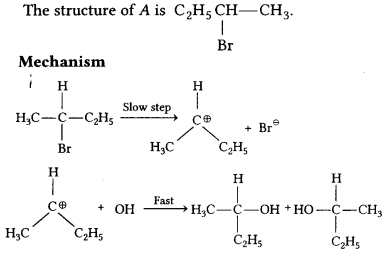
Question 28.
The rate constants of a reaction at 200K and 500K are 0.02
s-1 and 0.20 s-1 respectively. Calculate the value of
Ea.
(Given : 2.303 R = 19.15 JK-1mol-1)
[3]
Answer: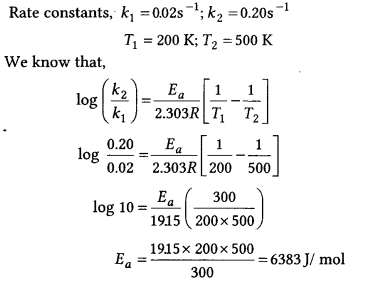
Section
D
(The following questions are
case-based questions. Each question has an internal choice and carries 4(1+1+2)
marks each. Read the passage carefully and answer the questions that
follow.)
Question 29.
Crystal Field Splitting by Various Ligands
Metal complexes show different colours due to d-d transitions. The complex
absorbs light of specific wavelength to promote the electron from t2g
to eg level. The colour of the complex is due to the transmitted
light, which is complementary of the colour absorbed. The wave number of light
absorbed by different complexes of Cr ion are given below.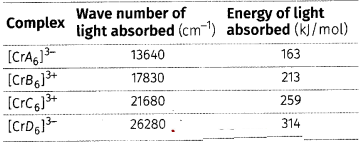
Answer the following questions. [4]
(a) Out of the ligands A, B, C and D which ligand causes maximum crystal
field splitting? Why?
Answer:
Energy is directly proprotional to the wave
number . Maximum energy of light is required for an electron to jump form
t2g to eg in case of [CrD6]3-.
Or
Which of the two, A or D will be a weak field ligand? Why?
(b) Which of
the complexes will be violet in colour? [CrA6]3- or
[CrB6]3+ and why?
(Given: If 560 – 570 nm of light is
absorbed, the colour of the complex observed is violet.)
(c) If the ligands
attached to Cr3+ ion in the complexes given in the table above are
water, cyanide ion, chloride ion, and ammonia (not in this order).
Identify
the ligand, write the formula and IUPAC name of the following.
(i)
[CrA6]3-
(ii) [CrC6]3+
Answer:
A weak field ligand causes the splitting of energy orbital (i.e
t2g and eg) with minimum extent. Hence, A is a weak field
ligand on the energy required is minimum.
(b) For [CrB6]3+, wavelength of light absorbed
\(=\frac{1}{\text { wave number }}\) = \(\frac{1}{17830}\) = 560 nm
For
[CrA6]3-, wavelength of light absorbed
=
\(\frac{1}{13640}\) = 733 nm.
Thus, E0
[CrB6]3+ complex is violet in colour.
(c) A = Cl– (weak field ligand ) , B = H2O , C =
NH3, D = CN– (strong field ligand)
(i)
[CrCl6]3 = Hexachloridochromate (III) ion
(ii)
[Cr(NH3)6]3+ = Hexaamminechromium (III) ion
Question 30.
The lead-acid battery represents the oldest rechargeable
battery technology. Lead acid batteries can be found in a wide variety of
applications including small-scale power storage such as UPS systems, ignition
power sources for automobiles, along with large, grid-scale power systems.
The spongy lead act as the anode and lead dioxide as the cathode. Aqueous
sulphuric acid is used as an electrolyte. The half-reactions during discharging
of lead storage cells are
At anode,
Pb(s) + S\(\mathrm{O}_4^{2-}\)(aq) →
PbSO4(s) + 2e–
At cathode,
PbO2(s) +
4H+(aq) + S\(\mathrm{O}_4^{2-}\)(ag) + 2e,sup>- →
PbSO4(s) + 2H2O
There is no safe way of disposal and these batteries end – up in landfills. Lead and sulphuric acid are extremely hazardous and pollute soil, water as well as air. Irrespective of the environmental challenges it poses, lead-acid batteries have remained an important source of energy.
Designing green and sustainable battery systems as alternatives to conventional means remains relevant. Fuel cells are seen as the future source of energy. Hydrogen is considered a green fuel. Problem with fuel cells at present is the storage of hydrogen. Currently, ammonia and methanol are being used as a source of hydrogen for fuel cell. These are obtained industrially, so add to the environmental issues.
If the problem of storage of hydrogen is overcome, is it stilla “greenfuel”? Despite being the most abundant element in the Universe, hydrogen does not exist on its own, so needs to be extracted from the water using electrolysis or separated from carbon fossil fuels. Both of these processes require a significant amount of energy which is currently more than that gained from the hydrogen itself. In addition, this extraction typically requires the use of fossil fuels.
More research is being conducted in this field to solve these problems. Despite the problem of no good means to extract hydrogen, it is a uniquely abundant and renewable source of energy, perfect for our future zero-carbon needs.
Answer the following questions. [4]
(a) How many coulombs have been transferred from anode to cathode in order to
consume one mole of sulphuric acid during the discharging of lead storage
cell?
(b) How much work can be extracted by using lead storage cell if each
cell delivers about 2.0 V of voltage? (1 F = 96500 C)
(c) Do you agree with
the statement-“Hydrogen is a green fuel.” Give your comments for and against
this statement and justify your views.
Answer:
(a) As, 2 Faradays (or 2
mol) have been transferred from anode to cathode to consume 2 moles of
H2SO4.
Therefore, 1 mole of
H2SO4,/sub> required 1 Faraday of electricity or 96500
coulombs.
(b) Given , E° = 2V, n = 2 , F = 96500
Wmax =-nFE° = – 2 ×
96500 × 2 = -386000 J
Then, 386000 J of work can be extracted using lead
storage cell when the cell is in use.
(c) Both Yes and No should be accepted as correct answer.
Hydrogen is a
green fuel. On combustion it emits water vapour and leaves no residue in the
air. However, at present there is no green method to obtain hydrogen. It is
obtained by electrolysis of water which use electricity obtained from fossil
fuels.
Or
Imagine you are a member of an agency funding scientific research. Which of
the following projects will you fund and why?
(a) Safe recycling of lead
batteries
(b) Extraction of hydrogen [4]
Answer:
(a) Safe recycling of
lead batteries.
Lead batteries are widely used batteries but their disposal
is an issue because currently, these are being thrown into landfills and no safe
method of disposal or recyling exists. Research on this project will lead to
reducing the pollution and health hazards.
(b) Fuel cell is a clean source of energy but the current problem is obtaining/extraction of hydrogen. Research on this project will reduce the pollution problem and find a sustainable solution.
Section
E
(The following questions are
long answer type and carry 5 marks each. All questions have an internal
choice.)
Question 31.
Attempt any five of the following. [5]
(a) Which of the
following ions will have a magnetic moment value of 1.73 BM?
Sc3+,
Ti3+, Ti2+, Cu2+, Zn2+
(b) In
order to protect iron from corrosion, which one will you prefer as a sacrificial
electrode, Ni or Zn? Why?
(Given : Standard electrode potentials of Ni, Fe
and Zn are -0.25 V, -0.44 V and -0.76 V respectively.)
(c) The second
ionisation enthalpies of chromium and manganese are 1592 and 1509 kJ/mol
respectively. Explain the lower value of Mn.
(d) Give two similarities in the
properties of Sc and Zn.
(e) What is actinoid contraction? What causes
actinoid contraction?
(f) What is the oxidation state of chromium in chromate
ion and dichromate ion?
(g) Write the ionic equation for reaction of KI with
acidified KMnO4.
Answer:
(a) Among the given option,
Ti3+ and Cu2+ have 1 unpaired of electron. Thus , their
magnetic moment is 1.73 or \(\sqrt{3}\).
(b) Zinc can be used as sacrificial
metals as, it is more reactive than iron and lose its electrons in preference to
iron. This prevent iron from losing its electrons and becoming oxidised.
(c)
Electronic configuration of Mn+ = 3d54s1
Electronic configuration of Cr+ = 3d5
As Cr+
has stable half-filled electronic configuration thus, it requires more
ionisation energy to remove electron from stable configuration whereas,
Mn+ has 1 electron in 4s1 which can easily be removed.
Thus, its ionisation energy is less.
(d) Sc in its common +3 oxidation state
has no electron in 3d-orbital and Zn has no unpaired electron in its 3d-orbital
in either its atomic state or ionic state. Thus, both Sc and Zn form colourless
compound and are diamagnetic.
(e) The radii of trivalent and quadrivalent
ions of actinoids contract slightly with increasing atomic number. This
contraction is known as actinoid contraction. This results from poor shielding
experienced by 5/-electrons.
(f) The oxidation state in chromate ion
\(\left[\mathrm{Cr}_2 \mathrm{O}_4^{2-}\right]\) and dichromate ion
\(\left[\mathrm{Cr}_2 \mathrm{O}_7^{2-}\right]\) is +3 and +6 respectively.
(g) 2MnO4 + 10I– + 6H+ → 2Mn2+ +
8H2O + 5I2
Question 32.
(a) What is the effect of temperature on the solubility of
glucose in water? [5]
(b) Ibrahim collected lOmL eactrofjresh water and ocean
water. He observed that one sample labelled P froze at 0°C while the other Q at
-1.3°C. Ibrahim forgot which of the two, P or Q was ocean water. Help him
identify which container contains ocean water, giving rationalisation for your
answer.
(c) Calculate van’t Hoff factor for an aqueous solution of
K3[Fe(CN)6] if the degree of dissociation (α) is 0.852.
What will be the boiling point of this solution if its concentration is 1 molal?
(Kb = 0.52 K kg/mol)
Answer:
(a) The solubility of glucose in
water, increases with increase in temperature.
(b) Q is ocean water because
due to the presence of salts it freezes at lower temperature (depression in
freezing point).
(c) Degree of dissociation of
K3[Fe(CN)6] = 0.852
Kb = 0.52 K kg / mol
K3[Fe(CN)6] gives 4 ions in aqueous solution
i = 1 + (n
– 1)α
= 1 + (4 – 1) × 0.852 = 3.556
∆Tb = iKbm =
3.556 × 0.52 × 1 = 1.85°C
∆Tb = 1.85°C
Tb = 100 +
1.85°C = 1018.5° C
Or
(a) What type of deviation from Raoult’s law is expected when phenol and
aniline are mixed with each other? What change in the net volume of the mixture
is expected? Graphically represent the deviation.
(b) The vapour pressure of
pure water at a certain temperature is 23.80 mm Hg.
If 1 mole of a non-
volatile non- electrolytic solute is dissolved in 100g water, calculate the
resultant vapour pressure of the solution. [5]
Answer:
(a) The negative
deviation is expected when phenol and aniline are mixed with each other. The net
volume of the mixture will decrease, (∆T = 0) due to stronger intermolecular
interactions.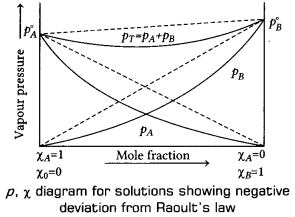
(b) Vapour pressure of pure water = 23.80 mmHg
Amount of
non-volatile electrolyte solute = 1 mol
Amount of water = 100 g
We know,
relative lowering of vapour pressure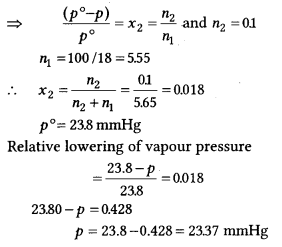
Question 33.
An organic compound with molecular formula
C7H7NO2 exists in three isomeric forms, the
isomer ‘A’ has the highest melting point of the three. ‘A’ on reduction gives
compound ‘B’ with molecular formula C7H9N. ‘B’ on
treatment with NaNO2 /HCl at 0-5 °C to form compound ‘C’. On treating
C with H3PO2, it gets converted to D with formula
C7H8, which on further reaction with
CrO2Cl2 followed by hydrolysis forms ‘E’
C7H6O. Write the structure of compounds A to E. Write the
chemical equations involved. [5]
Answer:
Compound having molecular formula
C7H7NO2 is
Among these 3 forms, (A) p-methylnitrobenzene has highest
melting point due to greater symmetry, which on reaction with Sn/HCl is reduced
to C7H9N, i.e. (p-methylbenzenamine) (B).
(B) on
treatment with NaNO2/HCl forms diazonium salt of p-methylbenzene
(C).
On treating (C) with hypophosphorus acid forms toluene (D). D on
oxidation forms benzaldehyde (E).
The chemical reaction involved is
Or
(a) Account for the following. [5]
(i) N-ethylbenzenesulphonyl amide is
soluble in alkali.
(ii) Reduction of nitrobenzene using Fe and HCl is
preferred over Sn and HCl.
Answer:
(i) The hydrogen attached to nitrogen
in N-ethylbenzene sulphonylamide is strongly acidic in nature due to the
presence of strong electron withdrawing group, i.e. sulphonyl group.
Hence,
it is soluble in alkali.
(ii) Reduction of nitrobenzene using Fe and HCl is preferred because
FeCl2 formed during the reaction get hydrolysed to release HCl.
Thus, only a small amount of HCl is required to initiate the reaction.
(b) Arrange the following in
(i) decreasing order of pKb values
C6H5NH2,
C6H5NHCH3,
C6H5CH2NH2,
CH3NH2, NH3
(ii) increasing order of
solubility in water C2H5Cl,
C2H5NH2, C2H5OH
(iii)
decreasing boiling point
CH3COOH, C2H5OH,
CH3NH2, CH3OCH3
Answer:
(i)
Higher the pKb value, weaker is the base.
Decreasing order of
pKb value is
C6H5NH2 >
C6H5NHCH3 > NH3 >
C6H5CH2NH2 >
CH3NH2
(ii) Increasing order of solubility in
water.
C2H5Cl <
C2H5NH2 < C2H5OH.
(iii) Decreasing boiling point order is
CH3COOH >
C2H5OH > CH3NH2 >
CH3OCH3